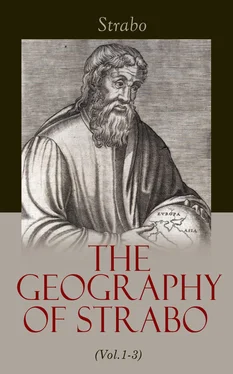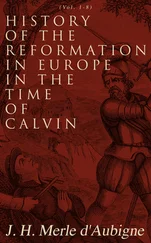Strabo - The Geography of Strabo (Vol.1-3)
Здесь есть возможность читать онлайн «Strabo - The Geography of Strabo (Vol.1-3)» — ознакомительный отрывок электронной книги совершенно бесплатно, а после прочтения отрывка купить полную версию. В некоторых случаях можно слушать аудио, скачать через торрент в формате fb2 и присутствует краткое содержание. Жанр: unrecognised, на английском языке. Описание произведения, (предисловие) а так же отзывы посетителей доступны на портале библиотеки ЛибКат.
- Название:The Geography of Strabo (Vol.1-3)
- Автор:
- Жанр:
- Год:неизвестен
- ISBN:нет данных
- Рейтинг книги:3 / 5. Голосов: 1
-
Избранное:Добавить в избранное
- Отзывы:
-
Ваша оценка:
- 60
- 1
- 2
- 3
- 4
- 5
The Geography of Strabo (Vol.1-3): краткое содержание, описание и аннотация
Предлагаем к чтению аннотацию, описание, краткое содержание или предисловие (зависит от того, что написал сам автор книги «The Geography of Strabo (Vol.1-3)»). Если вы не нашли необходимую информацию о книге — напишите в комментариях, мы постараемся отыскать её.
The Geography of Strabo (Vol.1-3) — читать онлайн ознакомительный отрывок
Ниже представлен текст книги, разбитый по страницам. Система сохранения места последней прочитанной страницы, позволяет с удобством читать онлайн бесплатно книгу «The Geography of Strabo (Vol.1-3)», без необходимости каждый раз заново искать на чём Вы остановились. Поставьте закладку, и сможете в любой момент перейти на страницу, на которой закончили чтение.
Интервал:
Закладка:
8. I cannot tell how it is that Posidonius, who describes the Phœnicians as sagacious in other things, should here attribute [Pg 260]
[CAS. 173] to them folly rather than shrewdness. The sun completes his revolution in the space of a day and night, being a portion of the time beneath the earth, and a portion of the time shining upon it. Now he asserts that the motion of the sea corresponds with the revolution of the heavenly bodies, and experiences a diurnal, monthly, and annual change, in strict accordance with the changes of the moon. For [he continues] when the moon is elevated one sign of the zodiac 1295above the horizon, the sea begins sensibly to swell and cover the shores, until she has attained her meridian; but when that satellite begins to decline, the sea again retires by degrees, until the moon wants merely one sign of the zodiac from setting; it then remains stationary until the moon has set, and also descended one sign of the zodiac below the horizon, when it again rises until she has attained her meridian below the earth; it then retires again until the moon is within one sign of the zodiac of her rising above the horizon, when it remains stationary until the moon has risen one sign of the zodiac above the earth, and then begins to rise as before. Such he describes to be the diurnal revolution. In respect to the monthly revolution, [he says] that the spring-tides occur at the time of the new moon, when they decrease until the first quarter; they then increase until full moon, when they again decrease until the last quarter, after which they increase till the new moon; [he adds] that these increases ought to be understood both of their duration and speed. In regard to the annual revolution, he says that he learned from the statements of the Gaditanians, that both the ebb and flow tides were at their extremes at the summer solstice: and that hence he conjectured that they decreased until the [autumnal] equinox; then increased till the winter solstice; then decreased again until the vernal equinox; and [finally] increased until the summer solstice. But since these revolutions occur twice in the four-and-twenty hours, the sea rising twice and receding twice, and that regularly every day and night, how is it that the filling and failing of the well do not frequently occur during the ebb and flow of the tide? or if it be allowed that this does often occur, why does it not do so in the same proportion? and if it does so in the same proportion, how comes it that the Gaditanians are not competent to observe what is of daily occurrence, while they are nevertheless competent to the observing of revolutions which occur but once in the year. That Posidonius himself credited these reports is evident from his own conjecture respecting the decrease and increase [of the sea] from solstice to solstice. However, it is not likely, being an observant people, that they should be ignorant of what actually occurred, whilst giving credit to imaginary phenomena.
9. Posidonius tells us that Seleucus, a native of the country next the Erythræan Sea, 1296states that the regularity and irregularity of the ebb and flow of the sea follow the different positions of the moon in the zodiac; that when she is in the equinoctial signs the tides are regular, but that when she is in the signs next the tropics, the tides are irregular both in their height and force; and that for the remaining signs the irregularity is greater or less, according as they are more or less removed from the signs before mentioned. Posidonius adds, that during the summer solstice and whilst the moon was full, he himself passed many days in the temple of Hercules at Gades, but could not observe any thing of these annual irregularities. However, about the new moon of the same month he observed at Ilipa 1297a great change in the reflux of the water of the Guadalquiver, as compared with previous flood-tides, in which the water did not rise half as high as the banks, and that then the water poured in so copiously, that the soldiers there dipped their supply without difficulty, although Ilipa is about 700 stadia from the sea. He says, that the plains next the sea were covered by the tides to a distance of 30 1298stadia, and to such a depth as to form islands, while the basement of the temple in the enclosure dedicated to Hercules, and the top of the mole in front of the harbour of Gades, were not covered higher than 10 cubits, as observed by actual soundings; but if any one should add the double of that for the occasional risings of the tide which occur, [neither] thus would he be able to estimate the violence with which the full force of the high tide rushes over the plains. Posidonius informs us that this violence [of the tide] is common to all the coasts of Spain on the Atlantic, 1299but what he [Pg 262] [CAS. 175] relates concerning the Ebro is unusual and peculiar to itself, for he says that it sometimes overflows after continued north winds, although there may have been neither rains nor snows. The cause of this [he supposes] to be the lake through which the Ebro flows, its waters being driven by the winds into the current of the river. 1300
10. The same writer mentions a tree at Gades, which had boughs reaching to the ground; its sword-shaped leaves often measuring a cubit long, and four fingers broad. Also that about Carthagena there was a tree whose thorns produced a bark from which most beautiful stuffs were woven. As for the tree [he saw] at Gades, we ourselves have observed a similar in Egypt, so far as the inclination of the boughs is concerned, but with a differently shaped leaf, and producing no fruit, which according to him the other did. In Cappadocia there are stuffs made from thorns, but it is not a tree which produces the thorn from which the bark is taken, but a low plant; he also tells us of a tree at Gades, from which if a branch be broken off a milk will flow, and if the root be cut a red fluid runs. Thus much for Gades.
11. The Cassiterides are ten in number, and lie near each other in the ocean towards the north from the haven of the Artabri. One of them is desert, but the others are inhabited by men in black cloaks, clad in tunics reaching to the feet, girt about the breast, and walking with staves, thus resembling the Furies we see in tragic representations. 1301They subsist by their cattle, leading for the most part a wandering life. Of the metals they have tin and lead; which with skins they barter with the merchants for earthenware, salt, and brazen vessels. Formerly the Phœnicians alone carried on this traffic from Gades, concealing the passage from every one; and when the Romans followed a certain ship-master, that they also might find the market, the ship-master of jealousy purposely ran his vessel upon a shoal, leading on those who followed him into the same destructive disaster; he himself escaped by means of a fragment of the ship, and received from the state the value of the cargo he had lost. The Romans nevertheless by frequent efforts discovered the passage, and as soon as Publius Crassus, passing over to them, perceived that the metals were dug out at a little depth, and that the men were peaceably disposed, he declared it to those who already wished to traffic in this sea for profit, although the passage was longer than that to Britain. 1302Thus far concerning Iberia and the adjacent islands.
BOOK IV.
GAUL.
Table of Contents
SUMMARY.
The Fourth Book contains a description of the regions about Gaul, Spain, and the Alps on this side, towards Italy. Likewise of Britain, and of certain islands in the ocean which are habitable, together with the country of the barbarians, and the nations dwelling beyond the Danube.
CHAPTER I.
Table of Contents
1. Next in order [after Iberia] comes Keltica beyond the Alps, 1303the configuration and size of which has been already mentioned in a general manner; we are now to describe it more particularly. Some divide it into the three nations of the Aquitani, Belgæ, and Keltæ. 1304Of these the Aquitani differ completely from the other nations, not only in their language but in their figure, which resembles more that of the Iberians than the Galatæ. The others are Galatæ in countenance, although they do not all speak the same language, but some make a slight difference in their speech; neither is their polity and mode of life exactly the same. These writers give the name of Aquitani and Keltæ to the dwellers near the Pyrenees, which are bounded by the Cevennes. For it has been stated that this Keltica is bounded on the west by the mountains of the Pyrenees, which extend to either sea, both the Mediterranean and the ocean; on the east by the Rhine, which is parallel to the Pyrenees; on the north by the ocean, from the northern extremities of the Pyrenees to the mouths of the Rhine; on the south by the sea of Marseilles, and Narbonne, and by the Alps from Liguria to the sources of the Rhine. The Cevennes lie at right angles to the Pyrenees, and traverse the plains for about 2000 stadia, terminating in the middle near Lugdunum. 1305They call those people Aquitani who inhabit the northern portions of the Pyrenees, and the Cevennes extending as far as the ocean, and bounded by the river Garonne; and Keltæ, those who dwell on the other side of the Garonne, towards the sea of Marseilles and Narbonne, and touching a portion of the Alpine chain. This is the division adopted by divus Cæsar in his Commentaries. 1306But Augustus Cæsar, when dividing the country into four parts, united the Keltæ to the Narbonnaise; the Aquitani he preserved the same as Julius Cæsar, but added thereto fourteen other nations of those who dwelt between the Garonne and the river Loire, 1307and dividing the rest into two parts, the one extending to the upper districts of the Rhine he made dependent upon Lugdunum, the other [he assigned] [Pg 266] [CAS. 177] to the Belgæ. However, it is the duty of the Geographer to describe the physical divisions of each country, and those which result from diversity of nations, when they seem worthy of notice; as to the limits which princes, induced by a policy which circumstances dictate, have variously imposed, it will be sufficient for him to notice them summarily, leaving others to furnish particular details.
Читать дальшеИнтервал:
Закладка:
Похожие книги на «The Geography of Strabo (Vol.1-3)»
Представляем Вашему вниманию похожие книги на «The Geography of Strabo (Vol.1-3)» списком для выбора. Мы отобрали схожую по названию и смыслу литературу в надежде предоставить читателям больше вариантов отыскать новые, интересные, ещё непрочитанные произведения.
Обсуждение, отзывы о книге «The Geography of Strabo (Vol.1-3)» и просто собственные мнения читателей. Оставьте ваши комментарии, напишите, что Вы думаете о произведении, его смысле или главных героях. Укажите что конкретно понравилось, а что нет, и почему Вы так считаете.












![Anne Blunt - A Pilgrimage to Nejd, the Cradle of the Arab Race. Vol. 2 [of 2]](/books/750183/anne-blunt-a-pilgrimage-to-nejd-the-cradle-of-the-thumb.webp)